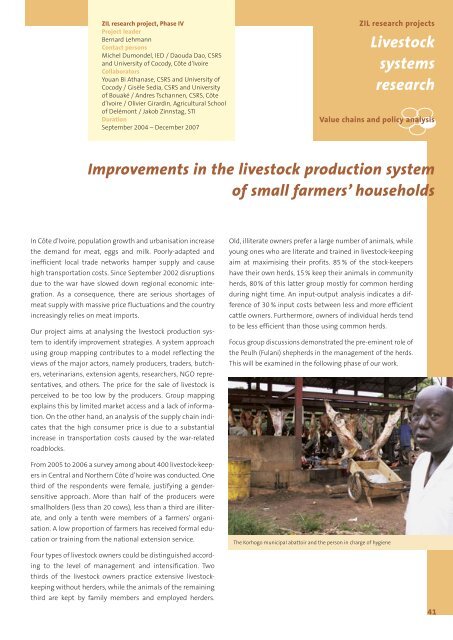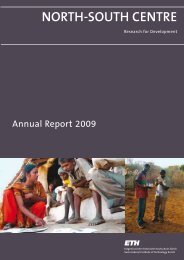Annual Report 2006/07 - ETH - North-South Centre North-South ...
Annual Report 2006/07 - ETH - North-South Centre North-South ...
Annual Report 2006/07 - ETH - North-South Centre North-South ...
You also want an ePaper? Increase the reach of your titles
YUMPU automatically turns print PDFs into web optimized ePapers that Google loves.
ZIL research project, Phase IVProject leaderBernard LehmannContact personsMichel Dumondel, IED / Daouda Dao, CSRSand University of Cocody, Côte d’IvoireCollaboratorsYouan Bi Athanase, CSRS and University ofCocody / Gisèle Sedia, CSRS and Universityof Bouaké / Andres Tschannen, CSRS, Côted’Ivoire / Olivier Girardin, Agricultural Schoolof Delémont / Jakob Zinnstag, STIDurationSeptember 2004 – December 20<strong>07</strong>ZIL research projectsLivestocksystemsresearchValue chains and policy analysisImprovements in the livestock production systemof small farmers’ householdsIn Côte d’Ivoire, population growth and urbanisation increasethe demand for meat, eggs and milk. Poorly-adapted andinefficient local trade networks hamper supply and causehigh transportation costs. Since September 2002 disruptionsdue to the war have slowed down regional economic integration.As a consequence, there are serious shortages ofmeat supply with massive price fluctuations and the countryincreasingly relies on meat imports.Our project aims at analysing the livestock production systemto identify improvement strategies. A system approachusing group mapping contributes to a model reflecting theviews of the major actors, namely producers, traders, butchers,veterinarians, extension agents, researchers, NGO representatives,and others. The price for the sale of livestock isperceived to be too low by the producers. Group mappingexplains this by limited market access and a lack of information.On the other hand, an analysis of the supply chain indicatesthat the high consumer price is due to a substantialincrease in transportation costs caused by the war-relatedroadblocks.From 2005 to <strong>2006</strong> a survey among about 400 livestock-keepersin Central and <strong>North</strong>ern Côte d’Ivoire was conducted. Onethird of the respondents were female, justifying a gendersensitiveapproach. More than half of the producers weresmallholders (less than 20 cows), less than a third are illiterate,and only a tenth were members of a farmers’ organisation.A low proportion of farmers has received formal educationor training from the national extension service.Old, illiterate owners prefer a large number of animals, whileyoung ones who are literate and trained in livestock-keepingaim at maximising their profits. 85 % of the stock-keepershave their own herds, 15 % keep their animals in communityherds, 80 % of this latter group mostly for common herdingduring night time. An input-output analysis indicates a differenceof 30 % input costs between less and more efficientcattle owners. Furthermore, owners of individual herds tendto be less efficient than those using common herds.Focus group discussions demonstrated the pre-eminent role ofthe Peulh (Fulani) shepherds in the management of the herds.This will be examined in the following phase of our work.The Korhogo municipal abattoir and the person in charge of hygieneFour types of livestock owners could be distinguished accordingto the level of management and intensification. Twothirds of the livestock owners practice extensive livestockkeepingwithout herders, while the animals of the remainingthird are kept by family members and employed herders.41
















